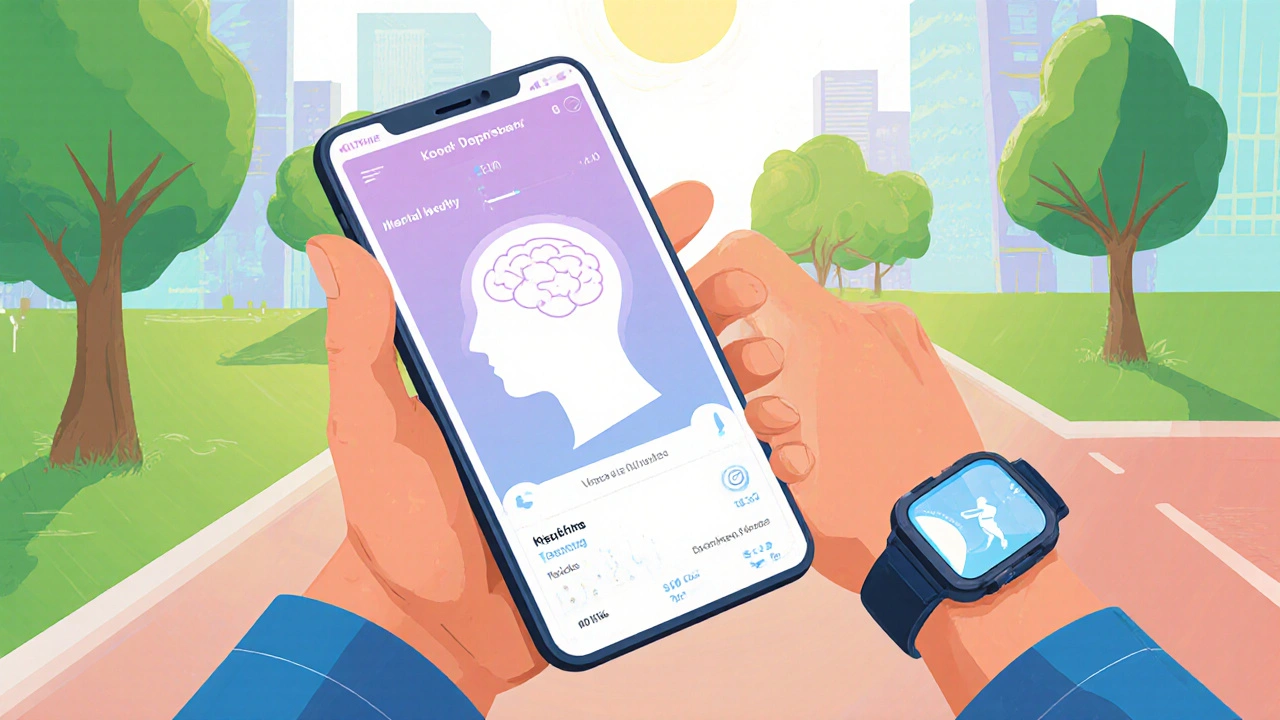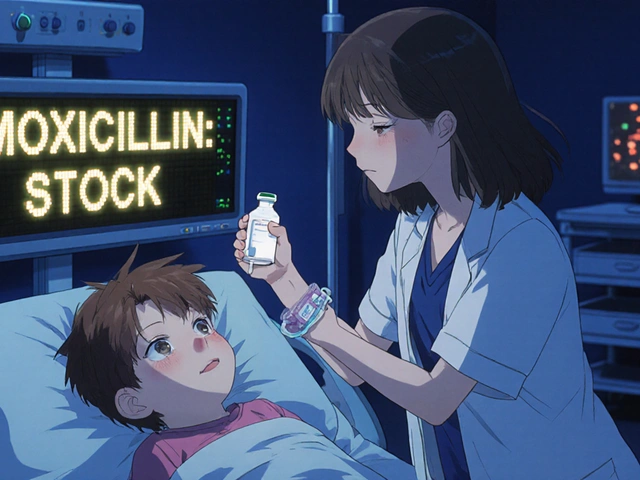PHQ-9 Depression Symptom Checker
Answer the following questions about how you've felt over the past two weeks:
When you hear the phrase Major Depressive Disorder is a persistent mood condition marked by overwhelming sadness, loss of interest, and physical fatigue. It affects more than 260 million people worldwide, making it a leading cause of disability. Fortunately, modern technology is reshaping how clinicians and patients tackle this challenge, offering tools that go beyond pills and weekly appointments.
Key Takeaways
- Digital tools-telepsychiatry, mobile apps, AI chatbots, wearables-can speed up diagnosis and personalize treatment.
- Clinical evidence shows that apps delivering Cognitive Behavioral Therapy (CBT) reduce depressive symptoms by 30% on average.
- Choosing the right tech requires considering data privacy, cost, clinical validation, and personal comfort.
- Integrating technology works best when it complements, not replaces, human support.
- Future trends include AI‑driven mood prediction and immersive virtual‑reality interventions.
Understanding Major Depressive Disorder
To use technology wisely, you first need a clear picture of the illness. Major Depressive Disorder is diagnosed when a person experiences at least five of nine core symptoms-persistent low mood, diminished pleasure, sleep changes, appetite shifts, low energy, feelings of worthlessness, concentration problems, and recurrent thoughts of death-for two weeks or more.
Risk factors range from genetics and chronic stress to hormonal changes and social isolation. Traditional treatment combines antidepressant medication with psychotherapy, most often Cognitive Behavioral Therapy (CBT). While effective for many, up to 40% of patients report partial or no response, prompting clinicians to explore supplemental options.
How Technology is Transforming Management
Technology does not aim to replace therapists; it expands the toolkit. Below are the five most impactful digital solutions.
Telepsychiatry
Telepsychiatry uses video conferencing to connect patients with mental‑health professionals. A 2023 meta‑analysis of 29 randomized trials found that telepsychiatry outcomes are statistically equivalent to in‑person care, with added benefits of reduced travel time and lower no‑show rates.
Platforms such as Zoom for Healthcare and dedicated services like Amwell meet HIPAA standards, ensuring encrypted sessions. For rural NewZealand users, telepsychiatry bridges the gap where specialist services are scarce.
Mobile Apps for Self‑Management
Mobile mental‑health apps put therapeutic exercises in your pocket. Popular options include Headspace, which offers guided mindfulness, and Woebot, an AI‑powered chatbot that teaches CBT skills through brief daily conversations.
Clinical trials of the FDA‑cleared app reSET‑MD reported a 33% reduction in PHQ‑9 scores after eight weeks of use. Most apps operate on a freemium model-basic content is free, while premium features (customized mood tracking, therapist‑directed assignments) require a subscription ranging from $5 to $15 per month.
AI Chatbots
AI chatbots simulate a therapeutic conversation, offering immediate coping strategies. Unlike static scripts, modern bots use natural‑language processing to adapt to user tone and context. A 2024 study comparing an AI chatbot to a human therapist in role‑play scenarios found comparable empathy scores, though bots still lag in handling severe crises.
When selecting a bot, verify that it includes safety protocols such as automatic escalation to emergency services if suicidal language is detected.
Wearable Sensors
Wearables like smartwatches collect physiological data-heart rate variability, sleep patterns, activity levels-that correlate with mood fluctuations. Researchers at the University of Auckland demonstrated that a machine‑learning model using wearable data could predict depressive episodes with 78% accuracy up to three days in advance.
Integrating these insights into a patient portal helps clinicians adjust treatment before symptoms worsen. Popular consumer devices (e.g., Apple Watch, Fitbit) now offer dedicated mental‑health dashboards.
Digital CBT Platforms
Digital CBT platforms deliver structured therapy modules online. SilverCloud and MoodGym combine interactive exercises, mood journals, and therapist feedback. A 2022 systematic review noted that digital CBT reduces PHQ‑9 scores by an average of 5 points-comparable to weekly face‑to‑face sessions.
These platforms usually require a clinician’s referral, which can be arranged through primary‑care networks or employer‑sponsored mental‑health programs.

Choosing the Right Tool: Decision Criteria
Not every tech solution fits every person. Use the checklist below to match your needs.
| Tool | Core Function | Typical Cost | Evidence Level | Ideal User |
|---|---|---|---|---|
| Telepsychiatry | Live video consultations | $50‑$150 per session | High (RCTs) | Patients needing regular clinician interaction, especially in remote areas |
| Mobile Apps | Self‑guided CBT, mindfulness | Free‑$15 per month | Moderate (Meta‑analyses) | Tech‑savvy individuals looking for supplemental practice |
| AI Chatbots | Instant conversational support | Free‑$10 per month | Low‑to‑moderate (Pilot studies) | People wanting quick coping tips between appointments |
| Wearable Sensors | Mood‑related physiological monitoring | $200‑$500 device + optional subscription | Emerging (Predictive models) | Patients comfortable sharing biometric data and interested in proactive alerts |
| Digital CBT Platforms | Structured online therapy programs | $100‑$300 per course | High (Controlled trials) | Those who prefer therapist‑guided modules but cannot attend in‑person |
Practical Steps to Integrate Technology into Your Care Plan
- Assess your current treatment gap. Are you missing regular check‑ins, struggling with medication side‑effects, or finding it hard to practice CBT homework?
- Talk to your clinician. Ask whether telepsychiatry, a specific app, or a wearable can be added safely. Many providers now have a digital‑health liaison.
- Start small. Choose one tool-perhaps a free CBT app-and set a daily reminder for ten minutes of use.
- Track outcomes. Use the PHQ‑9 questionnaire weekly to see if symptoms improve, and note any side effects or frustration.
- Iterate. If the first tool feels clunky, switch to another. The goal is a seamless, supportive routine.
Remember, technology should feel like a helpful companion, not a burden. If you notice increased anxiety from constant notifications, dial back or adjust settings.
Common Pitfalls & How to Avoid Them
- Data privacy concerns. Only use platforms that are HIPAA‑ or GDPR‑compliant. Review privacy policies and enable two‑factor authentication.
- Over‑reliance on self‑diagnosis. Apps can suggest patterns, but a qualified clinician must confirm any treatment changes.
- Device fatigue. Wearing a sensor 24/7 can feel invasive. Schedule “off‑hours” and keep the device off during restful evenings.
- Cost creep. Subscriptions add up. Set a budget and prioritize tools with proven efficacy.
What the Future Holds
Emerging AI models are learning to predict mood swings from language use in text messages, offering pre‑emptive interventions. Virtual‑reality exposure therapy is already showing promise for anxiety comorbid with depression. By 2027, we expect most public‑health systems to embed a digital‑prescription module, allowing doctors to “prescribe” an FDA‑cleared app alongside medication.
These advances will likely make mental‑health care more personalized, data‑driven, and accessible-especially for underserved communities.

Frequently Asked Questions
Can I use mental‑health apps without seeing a therapist?
Yes, many evidence‑based apps are designed for self‑management and can be a first step. However, if you experience severe symptoms-such as thoughts of self‑harm-seek professional help immediately. Apps complement, not replace, clinical care.
Is my personal data safe when using wearable sensors?
Reputable manufacturers encrypt data both on‑device and during transmission. Look for GDPR or HIPAA compliance statements. Always review the privacy settings and limit data sharing to only what your clinician needs.
How often should I check my PHQ‑9 scores when using digital tools?
A weekly check‑in is a good balance. It captures trends without becoming obsessive. If you notice rapid changes, inform your provider right away.
Do insurance plans cover telepsychiatry or app subscriptions?
Many insurers now reimburse telepsychiatry visits at parity with in‑person rates. Coverage for app subscriptions varies; some health plans include digital‑therapy benefits, especially when prescribed by a clinician.
What should I do if a chatbot suggests I’m at risk of suicide?
Most reputable bots have built‑in emergency protocols that provide crisis‑line numbers and can alert a preset emergency contact. Treat that guidance as a call to immediate professional help-dial emergency services or go to the nearest emergency department.









Write a comment
Your email address will be restricted to us